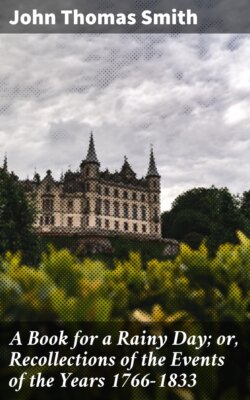Читать книгу A Book for a Rainy Day; or, Recollections of the Events of the Years 1766-1833 - John Thomas Smith - Страница 14
На сайте Литреса книга снята с продажи.
1772.
ОглавлениеTable of Contents
My dear mother’s declining state of health urged my father to consult Dr. Armstrong,[38] who recommended her to rise early and take milk at the cowhouse. I was her companion then; and I well remember that, after we had passed Portland Chapel, there were fields all the way on either side. The highway was irregular, with here and there a bank of separation; and that when we had crossed the New Road, there was a turnstile (called in an early plan, which I have seen since, “The White House”), at the entrance of a meadow leading to a little old public-house, the sign of the “Queen’s Head and Artichoke”: it was much weather-beaten, though perhaps once a tolerably good portrait of Queen Elizabeth. The house was reported to have been kept by one of Her Majesty’s gardeners.[39]
A little beyond a nest of small houses contiguous, was another turnstile opening also into fields, over which we walked to the Jew’s Harp House, Tavern and Tea Gardens.[40] It consisted of a large upper room, ascended by an outside staircase, for the accommodation of the company on ball nights; and in this room large parties dined. At the south front of these premises was a large semicircular enclosure with boxes for tea and ale drinkers, guarded by deal-board soldiers between every box, painted in proper colours. In the centre of this opening were tables and seats placed for the smokers. On the eastern side of the house there was a trapball-ground; the western side served for a tennis-hall; there were also public and private skittle-grounds. Behind this tavern were several small tenements, with a pretty good portion of ground to each. On the south of the tea-gardens a number of summer-houses and gardens, fitted up in the truest Cockney taste; for on many of these castellated edifices wooden cannons were placed; and at the entrance of each domain, of about the twentieth part of an acre, the old inscription of “Steel-traps and spring-guns all over these grounds,” with an “N.B. Dogs trespassing will be shot.”
In these rural retreats the tenant was usually seen on Sunday evening in a bright scarlet waistcoat, ruffled shirt, and silver shoe-buckles, comfortably taking his tea with his family, honouring a Seven-Dial friend with a nod on his peregrination to the famed Wells of Kilburn. Willan’s farm,[41] the extent of my mother’s walk, stood at about a quarter of a mile south; and I remember that the room in which she sat to take the milk was called “Queen Elizabeth’s Kitchen,” and that there was some stained glass in the windows.
On our return we crossed the New Road; and, after passing the back of Marylebone Gardens,[42] entered London immediately behind the elegant mansions on the north side of Cavendish Square. This Square was enclosed by a dwarf brick wall, surmounted by heavy wooden railing. Harley Fields had for years been resorted to by thousands of people, to hear the celebrated Mr. George Whitefield, whose wish, like that of Wesley, when preaching on execution days at Kennington Common, was to catch the ears of the idlers. I should have noticed Kendall’s farm,[43] which in 1746 belonged to a farmer of the name of Bilson, a pretty large one, where I have seen eight or ten immense hay-ricks all on a row; it stood on the site of the commencement of the present Osnaburg Street, nearly opposite the “Green Man,” originally called the “Farthing Pie House.”[44]
“SING TANTARARA—VAUXHALL! VAUXHALL!”
To the honour of our climate, which is often abused, perhaps no country can produce instances of longevity equal to those of England of this year, viz.:—at 100, 2; 101, 5; 102, 6; 103, 3; 105, 4; 106, 3; 107, 4; 108, 5; 109, 4; 110, 2; 111, 2; 112, 3; 114, 1; 118, 1; 125, Rice, a cooper in Southwark; 133, Mrs. Keithe, at Newnham, in Gloucestershire; 138, the widow Chun, at Ophurst, near Lichfield.[45]
